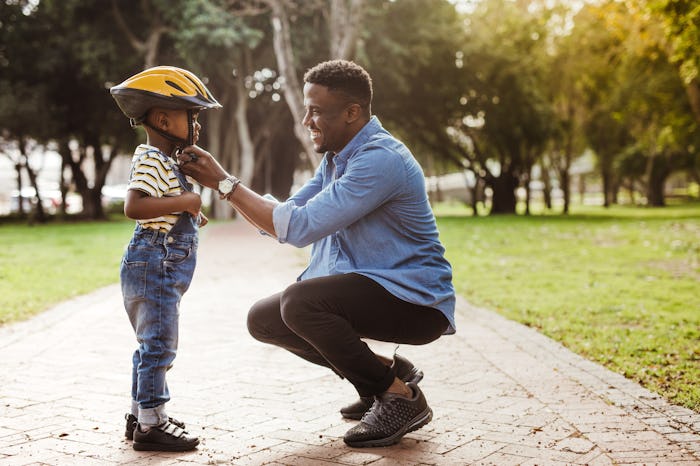Life

Bike Helmets Are Non-Negotiable, So Here's How To Convince Your Kid To Wear One
The day that your child learns how to ride a bicycle for the first time is typically one filled with a myriad of emotions — nervousness, frustration, and excitement all appear at some point during the process. Some of the frustration may not come from your child learning a new skill, but from yourself as you struggle to convince your child that wearing a helmet is a non-negotiable part of riding a bike. Truly, it happens to the best of us, which is why knowing how to get your kid to wear a bike helmet is a skill set you might want to have in your back pocket when they start riding.
Wearing a bike helmet might seem like a no-brainer (see what I did there?) to adults, but some kids are extremely resistant to the thought of strapping a protective shell on top of their head. Because the CDC reported that in the United States, approximately 80 to 90 percent of kids have a bicycle by the time they are in second grade, it is imperative to ensure their safety while riding. Child psychologist and expert on sensitive children, Maureen Healy, author of The Emotionally Healthy Child and parenting coach at Growinghappykids.com tells Romper why children may resist wearing a bicycle helmet regardless of the known consequences of not doing so.
"Children resist anything that is uncomfortable. This temporary discomfort however can prevent permanent damage. Helping children get more comfortable wearing a helmet is important, and you may take them on shorter bike or scooter rides to get them comfortable," Healy says.
The most effective way to prevent head injuries while riding a bicycle is to wear a properly-fitted helmet, according to the U.S. Department of Transportation bicycle safety guidelines. One study in the International Journal of Epidemiology found that wearing a helmet when riding a bicycle reduces the risk of head injury by 51 percent. These recommendations and statistics, combined with distracted driving culture, help support Healy's explanation of why and how you can make your child agree to wear a bike helmet.
"I would not — under any circumstance — let my child ride a bicycle without a secure helmet, especially in today's world of fast drivers, people texting and driving, as well as other obstacles to their safety," Healy says. "The point is to help your son or daughter understand the importance without inciting fear in them, but helping them recognize or appreciate how important safety is — and it may require getting used to the feeling of a secure helmet."
Healy also recommends connecting with your child and becoming attune to how they feel about wearing a helmet. "Acknowledge that the helmet may not be comfortable, but focus on why it's important," Healy says. "You simply don't get a replacement head and your brain is in your head, which needs to be kept safe."
So, other than expressing the importance of wearing a helmet like a broken record on repeat and helping them get used to the feel of a helmet, what can you do as a parent to make the entire process less frustrating? The Bicycle Hemet Institute suggests on their website that parents encourage their child to help select a safe bicycle helmet in a fun color or pattern to help them get more joy from wearing a helmet.
Additionally, modeling the behavior your want from your child by wearing a helmet yourself when you ride a bicycle can help encourage your kids to follow suit. Pointing out professional athletes such as football players or hockey players who wear helmets to protect their brains can also be helpful, according to The Bicycle Helmet Institute website.
In addition to ensuring that your child wears a helmet when riding a bike, Healy also recommends that parents help their child get a good fit in order to ensure their safety. "Not only explain how important the helmet is to keep their brain safe and body strong, but focus on how they need to keep it on their head securely," Healy says. "One of the biggest problems with helmets is that children wear them incorrectly (as well as adults) and they don't keep the noggin safe, which is of utmost importance. Brain injuries are one of the scariest and most irreparable injuries that exist, which as someone who has cracked her helmet — I am profoundly grateful for having worn one."
This article was originally published on